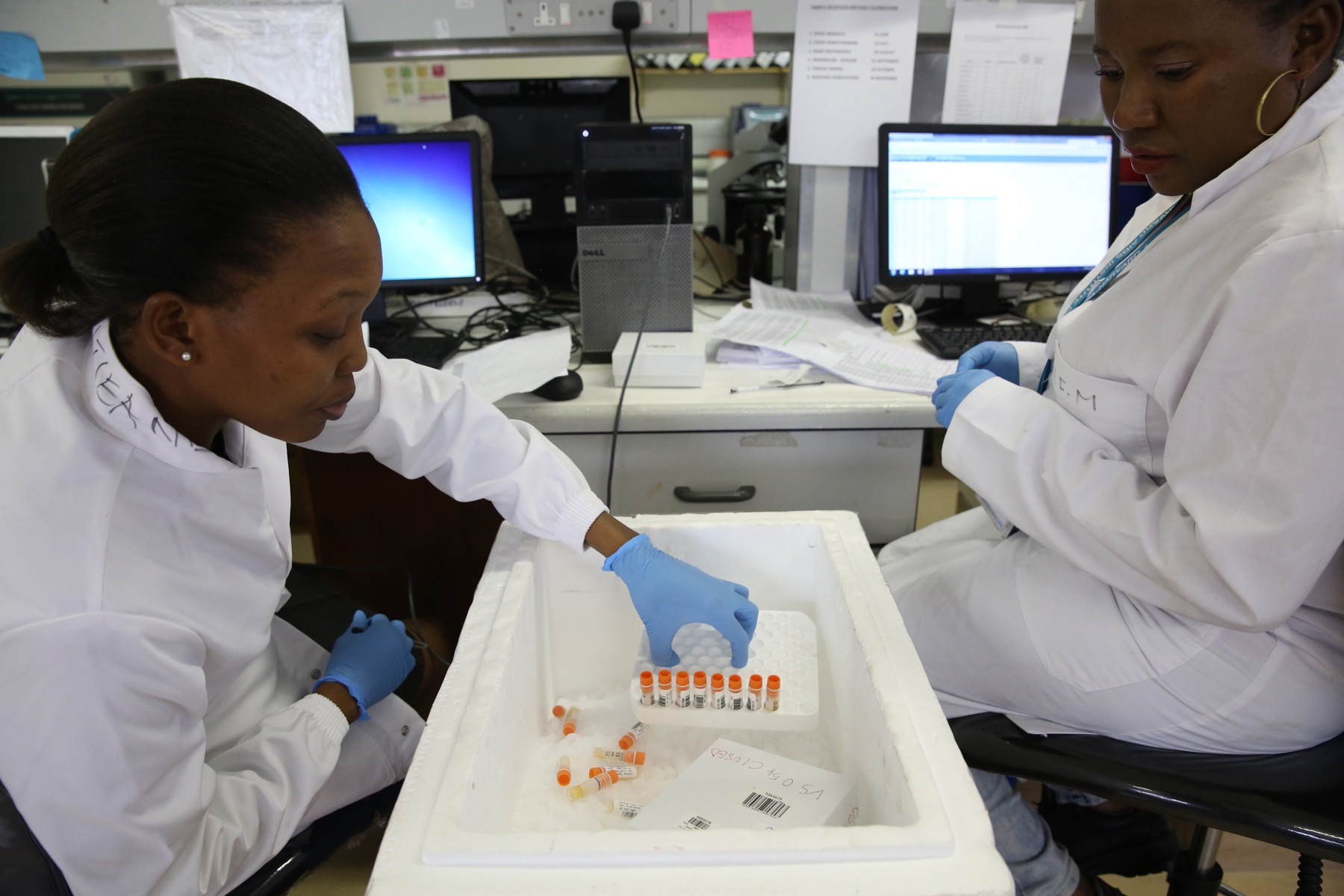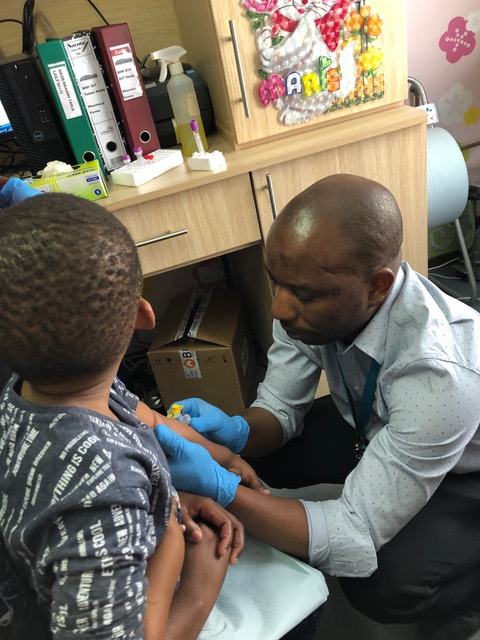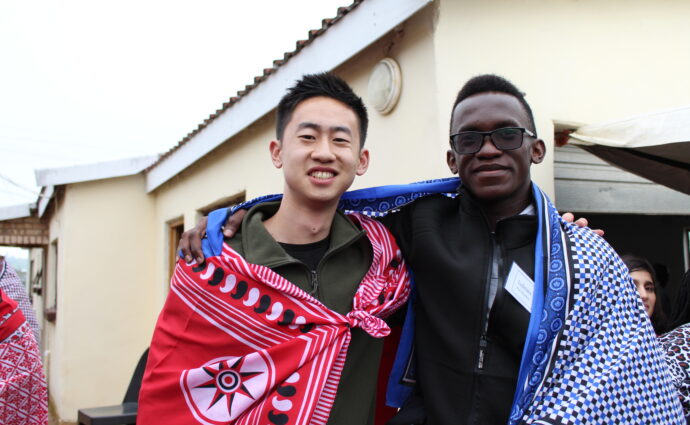Date: August 14, 2023 By: Nick Kolev

Two faculty members from the Ragon Institute took part in a clinical trial in Botswana that found a potential alternative treatment to antiretroviral therapy for children with HIV — an important step in the fight to eliminate the virus.
Mathias Lichterfeld, MD, PhD, and Xu Yu, MD, co-authored the paper, Broadly neutralizing antibody treatment maintained HIV suppression in children with favorable reservoir characteristics in Botswana, which was led by Roger Shapiro, MD, of the Harvard T.H. Chan School of Public Health.
The Tatelo Study — meaning “the next thing” in Setswana, Botswana’s national language — was a clinical trial to understand the effectiveness of bNAbs, or broadly neutralizing antibodies, in suppressing HIV viral loads in young children compared to the standard treatment of ART (antiretroviral therapy).
The study compared outcomes of infants treated with both ART and bNAbs as well as bNAbs alone. A number of infants treated under the bNAb-only phase of the trial maintained viral suppression, suggesting the potential for use of these antibodies in infants and children.
“Generally, treatment in infants with standard ART is a lot more difficult and outcomes have been worse compared to adults,” Lichterfeld explained. “That’s why we designed this study to figure out if there is an alternative treatment modality that would potentially be more effective.”
ART is not only challenging to administer to infants for those reasons, but also for practical concerns — it requires large pills taken daily that infants may struggle to swallow and caregivers may forget to administer them on time.
In contrast, bNAbs are special antibodies that target HIV and have been successfully used to control HIV replication in adults. They require subcutaneous injections given roughly every four weeks, a far more forgiving schedule should it ever be widely adopted as a treatment.

Until now, this strategy had not been studied in young people.
“We were studying what may be the ‘next thing’ in treating HIV in children,” Shapiro said in an interview with the Harvard Chan School. “There is hope that bNAbs may lead to an enhanced immune response against HIV, offering a path toward children being functionally cured of HIV.”
The study was conducted over a period of several years in collaboration with the Botswana Harvard Partnership, which had conducted screening programs to identify children born with HIV for further research.
The infants who were enrolled, aged two to six, had received ART from the first week of life and were already virally suppressed. Out of those 25, 11 remained virally suppressed through 24 weeks of bNAb treatment alone. This is a significant milestone that suggests a future path of treatment.
“We believe it’s important because for infants, it is so difficult to adhere to standard antiretroviral treatment,” Lichterfeld said. “Only a small proportion of all the drugs that are available for adults can be used in infants simply because there’s not a lot of experience in using them.”
The Tatelo Study gives encouraging insight into new ways to treat those afflicted with the virus — particularly in Africa where HIV is most widespread and access to treatment remains a challenge — but it is a long way off from being adopted as a new intervention.
“The fact that nearly half of the children maintained viral suppression on bNAbs shows that bNAbs are a promising long-acting treatment option,” Shapiro told the Harvard Chan School. “Of course, nearly half isn’t good enough—but this is a first proof-of-concept. It’s similar to data from the early 1990s that showed promise around combinations of antiretrovirals.”
Lichterfeld concurred, noting that the medication regimen used in the trial showed much potential but that it will take a lot of time before it can become a viable standard-of-care treatment. Future treatments would have to overcome broad viral diversity among the population to be widely effective.
“That’s always the concern with these antibody treatments, that they are designed to be very broadly cross reactive and recognize a lot of different types of viruses,” he said. “But there’s still certain viruses that are resistant to it.”
HIV remains a global threat, but particularly so for children who deal with much worse effects while having less capability to fight the virus. The research that Lichterfeld and Yu participate in is one step in fighting this problem.
“From a high-level perspective, pediatric HIV infection is a severe problem,” Lichterfeld said. ”There’s about 150,000 infants and children who are infected with HIV each year, and infants are having worse outcomes of the disease for various reasons.”
The next step, according to Lichterfeld and Shapiro, is a planned follow-up study using three different types of bNAbs that are broader and more potent to further identify how different modifications to the treatment strengthen or weaken its effectiveness — and potentially lead researchers closer to a broadly available treatment.
“We hope this will put us on the road to prolonged periods off treatment—or even a functional cure—for some children living with HIV,” Shapiro said.

The Ragon Institute is proud to recognize Upasana Das Adhikari, PhD, a postdoctoral fellow in the Kwon Lab, who has been awarded the prestigious K99 Pathway to Independence Award by the National Institutes of Health (NIH)

In January 2020, two students from across the world met on the “Evolution of an Epidemic” course. Their friendship inspired the creation of a program they hope will benefit African science for years to come.

The Ragon Institute is delighted to announce the upcoming launch of the Ragon Child Care Center at our new building at 600 Main Street. Operated by our renowned partners at Bright Horizons, the Ragon Child Care Center will offer top-notch early childhood education and care right at the heart of our community.